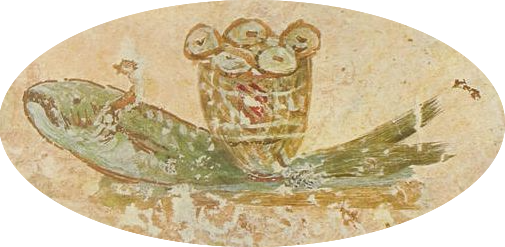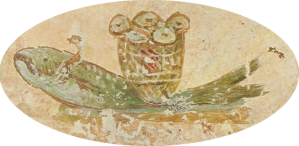| Günther Schwarz[*] |
ἰῶτα ἓν ἢ μία κεραία οὐ μὴ παρέλθῃ ἀπὸ τοῦ νόμου
“…not one iota nor one keraia will pass away from the law….”[1]
What the ἰῶτα (iōta) means in this passage is unequivocal: it refers to the letter י,[2] or, more precisely, to the word יוֹד (yōd), which is the name of this letter.[3]
What κεραία (keraia) means, on the other hand, is not as clear. Two explanations have been proposed. First, it may refer to “the decorations that were attached to certain letters (תגין [tagin], ‘little crowns’).”[4] Second, it may denote “the strokes that distinguish the letters ה ד ב from the similar ח ר כ”.[5]
But a different explanation, it seems to me, is closer to the truth and a bit more obvious: Just as ἰῶτα refers to יוֹד, the name of the tenth letter of the Hebrew alphabet, so κεραία refers to וָו (vāv), the name of the sixth letter.[6] Translated back into Aramaic, the above passage would then read: יוֹד חֲדָא אוֹ וָו חֲדָא.[7]
But how do we explain the mistaken rendering of וָו with κεραία?[8] Quite simply. The word וָו is ambiguous. It means 1. “hook”, 2. “the letter vav.”[9] From this it follows: Whoever translated Matt. 5:18 into Greek made the error of translating the וָו,[10] instead of merely transcribing it.[11]
Click here to return to the Whole Stones blog.
Notes
[*] This article originally appeared as Günther Schwarz, “ἰῶτα ἓν ἢ μία κεραία (Matthäus 5 18),” Zeitschrift für die neutestamentliche Wissenschaft 66.3-4 (1975): 268-269.
[1] Select bibliography: G. Dalman, Jesus-Jeschua (1922 = 1967), 56-58; W. G. Kümmel, “Jesus und der jüdische Traditionsgedanke,” ZNW 33 (1934): 105-130; W. D. Davies, “Matthew 5 17-18,” Mélanges Bibliques (Festschrilt für A. Robert) (1957), 428-456; A. Descamps, “Essai d’interprétation de Mt 5 17-48, »Formgeschichte« ou »Redaktionsgeschichte«,” Studia Evangélica TU 73 (1959), 156-173; E. Schweizer, “Matth. 5 17-20, Anmerkungen zum Gesetzesverständnis des Matthäus,” Neotestamentica (1963): 399-406; W. Trilling, Das wahre Israel (31964), 167-171; G. Barth, “Das Gesetzesverständnis des Evangelisten Matthäus,” Überlieferung und Auslegung im M atthäusevangelium (ed. G. Bornkamm, G. Barth, H. J. Held; 41965), 60-68; G. Strecker, Der Weg der Gerechtigkeit (21966), 143f.; H.-Th. Wrege, Die Überlieferungsgeschichte der Bergpredigt (1968), 38-40; V. Hasler, Amen, Redaktionsgeschichtliche Untersuchungen zur Einführungsformel der Herrenworte »Wahrlich, ich sage euch« (1969), 55-57; K. Berger, Die AmenWorte Jesu (1970), 73f.; S. Schulz, Q, Die Spruchquelle der Evangelisten (1972), 114-116.
[2] This is the general consensus.
[3] This corresponds to the fact that ίωτα is the name of the Greek letter ι.
[4] W. G. Kümmel (above, n. 1), 127.
[5] E. Lohmeyer, Das Evangelium des Matthäus (21958), 109 (with “crown” as an alternative).
[6] So in both cases Matt. 5:18 concerns letters (the second smallest and the smallest letter) of the Hebrew alphabet. According to Dalman, it was not the יוֹד, but the וָו that was the smallest letter: “Vav and yod were both represented at that period by a long perpendicular stroke. The yod was distinguished by having a small hook at the top, and was thus really larger than the vav.” Gustaf H. Dalman, The Words of Jesus Considered in the Light of Post-Biblical Jewish Writings and the Aramaic Language: I. Introduction and Fundamental Ideas (trans. D. M. Kay [Die Worte Jesu, 1898]; Edinburgh: T&T Clark, 1902), 6.
[7] In translation: “not one yod nor one vav.”
[8] Bauer Wb, (51958), 847: »d. Haken, d. Strichlein am Buchstaben« (“Hook,” “Small dashes on a letter”).
[9] G. Dalman, Aamäisch-neuhebräisches Wörtebuch zu Targum, Talmud und Midrasch (1938 = 1967), 121.
[10] After all, he reproduced the יוֹד, almost correctly, using the Greek equivalent ἰῶτα.
[11] If that is the case, then, contrary to the opinion of others, Matthew’s ἰῶτα ἓν ἢ (absent in Luke’s parallel [Luke 16:17]) is to be regarded as original, since יוֹד and וָו form a natural pair in reference to the Torah. Both letters stand side by side in parallelism with the pair ὁ οὐρανὸς καὶ ἡ γῆ in the preceding line.
Would you like to offer a correction or suggest an improved translation? You may do so below: |



Thanks to Chris Gast for finding a mistake. I’ve finally corrected it.
LikeLike